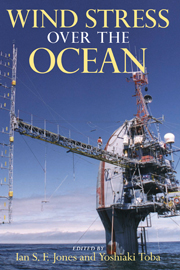Book contents
- Frontmatter
- Contents
- Preface
- Acknowledgements
- Contributors
- Frequently Used Symbols
- 1 Overview
- PART 1
- PART 2
- 8 The Influence of Swell on the Drag
- 9 The Influence of Unsteadiness
- 10 The Dependence on Wave Age
- 11 The Influence of Mesoscale Atmospheric Processes
- 12 Wind, Stress and Wave Directions
- 13 The Influence of Surface Tension
- 14 The Influence of Spatial Inhomogeneity: Fronts and Current Boundaries
- 15 Basin Boundaries
- References
- Index
11 - The Influence of Mesoscale Atmospheric Processes
Published online by Cambridge University Press: 16 October 2009
- Frontmatter
- Contents
- Preface
- Acknowledgements
- Contributors
- Frequently Used Symbols
- 1 Overview
- PART 1
- PART 2
- 8 The Influence of Swell on the Drag
- 9 The Influence of Unsteadiness
- 10 The Dependence on Wave Age
- 11 The Influence of Mesoscale Atmospheric Processes
- 12 Wind, Stress and Wave Directions
- 13 The Influence of Surface Tension
- 14 The Influence of Spatial Inhomogeneity: Fronts and Current Boundaries
- 15 Basin Boundaries
- References
- Index
Summary
Introduction
The sea surface drag has been discussed in terms of the bulk aerodynamic coefficient parametrization, CD. There are several factors that influence stress exerted by the atmosphere on the ocean surface and these are discussed in various chapters of this book. The influence of some mesoscale phenomena is the focus here. There are, for example, the characteristic large eddies that occur in the planetary boundary layer and the sharp changes associated with storms and convective events. Finally, the sparsity of data may mean that factors contributing to ocean stress remain unmeasured, unmodelled, and even unknown.
In the context of wind stress on the sea surface we have a twofold task: first to understand processes and their influence on the stress, and second to develop parametrizations and determine the coefficients. The bulk aerodynamic method using a drag coefficient or roughness length is a local parametrization. It can be modified by local or quasi-local influences like buoyancy stratification or wave age. Atmospheric processes are typically described by numerical models with a grid-scale of 50 km or 100 km. Observations at sea are considerably more sparse. Subgridscale atmospheric variations, especially of the wind, will influence the momentum transfer and thus result in apparently unexplained variations of the drag. The present chapter deals with influence of recognized structures that are not well represented in modelled surface layer variables or local measurements.
- Type
- Chapter
- Information
- Wind Stress over the Ocean , pp. 218 - 231Publisher: Cambridge University PressPrint publication year: 2001



